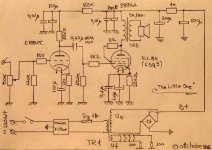I want to wire my DIY el84 se amp, from triode wired to pentode wired. Can I use a switch to change between triode to Pentode?, and how do I connect the switch?
Love the sound of my triode wired amp, but I am curious how the amp sounds , connected as a pentode.
Love the sound of my triode wired amp, but I am curious how the amp sounds , connected as a pentode.
Attachments
You connect the 22R to the top of the primary instead of the bottom.
But use HV switches, and do not switch them when powered up.
Also ground the secondary winding, it's a safety hazard.
But use HV switches, and do not switch them when powered up.
Also ground the secondary winding, it's a safety hazard.
Take a care on impedance of OT, the pentode config of 84 takes the Rp very high. (also the mu, of course)
Try it - you won't like it... the high plate resistance in pentode mode will make the frequency response much more dependent on the impedance of the speaker - resonances will be more pronounced and the rise in impedance vs. frequency due to inductance will cause a corresponding rise in the frequency response. It was common before the use of negative feedback to add a "tone" capacitor across the transformer primary to combat this effect. If there's enough gain (it's increased in pentode mode) you can add negative feedback, which will lower the output impedance, reduce distortion, and flatten frequency response.
Aaaaaah .... but you might like it! That would depend on your speakers, your listening room, what you listen to, how loud you listen, your musical taste .... and the amplifier. Based on the schematic, for output power up to around half a Watt, you would switch between:Try it - you won't like it...
- a small SET with moderate output impedance; and
- a small SEP with relatively high output impedance.
You could start off playing quietly and see how it treats your speakers and ears. Then you could slowly raise the volume to see if (or when 🙂 ) the bass starts to get a bit wild (or flabby!) or voices and instruments start to sound ragged (distorted) or just BAD.
It sounds like a fun experiment and, if it's not too much trouble, you could tell us all how it went!!
When the EL84/6BQ5 is pentode connected the circuit gain will increase.
Then there would be room for some NFB to get the damping factor back where there would be better speaker control.
As mentioned previously, connect one lead from the OPT secondary to common/ground.
Unhook the bypass cap from the driver cathode resistor, just one end will do.
Then for a start connect something like 10K from the other OPT secondary wire
to the cathode end of the driver tube cathode resister.
If the amp gets louder or distorts you probably have positive feedback. Reverse the OPT secondary leads.
Otherwise, try different values used as the feedback resistor. A scope & signal generator is a great help
during this procedure. 🙂
Then there would be room for some NFB to get the damping factor back where there would be better speaker control.
As mentioned previously, connect one lead from the OPT secondary to common/ground.
Unhook the bypass cap from the driver cathode resistor, just one end will do.
Then for a start connect something like 10K from the other OPT secondary wire
to the cathode end of the driver tube cathode resister.
If the amp gets louder or distorts you probably have positive feedback. Reverse the OPT secondary leads.
Otherwise, try different values used as the feedback resistor. A scope & signal generator is a great help
during this procedure. 🙂
There are Millions of single ended beam power tube amplifiers in old AM radios.
One fairly common thing about those old radios . . . No negative feedback.
Hardly anybody complained back then.
If you do not think the engineers thought about how a small table top open back radio sounded, and you think they did not do some selection of parts, circuit, and speaker drivers, think again.
Example: With the low damping factor, rising output voltage due to the voice coil inductance, and the high frequency roll off of the cone, the frequency response sometimes came out sounding OK.
Just my opinion and experience
One fairly common thing about those old radios . . . No negative feedback.
Hardly anybody complained back then.
If you do not think the engineers thought about how a small table top open back radio sounded, and you think they did not do some selection of parts, circuit, and speaker drivers, think again.
Example: With the low damping factor, rising output voltage due to the voice coil inductance, and the high frequency roll off of the cone, the frequency response sometimes came out sounding OK.
Just my opinion and experience
I want to wire my DIY el84 se amp, from triode wired to pentode wired. Can I use a switch to change between triode to Pentode?, and how do I connect the switch?
Love the sound of my triode wired amp, but I am curious how the amp sounds , connected as a pentode.
So, what did you do finally, and how did it sound? Please enlighten us, @stenak
It was probably by chance that the form appeared after an online search. Never tested it pentode connected. I used the form I found on the internet. With Hammond 125 output transformers, it goes "far" down into the bass range, pleasant midrange and treble. Gives about 1.5 watts class A, and on my Klipsch RP 160M, 1.5 watts is enough to fill the living room with great sound
- Home
- Amplifiers
- Tubes / Valves
- From triode wired to pentode wired
